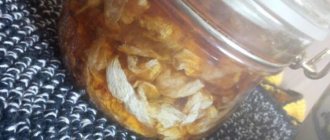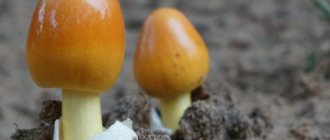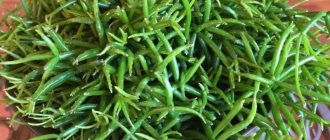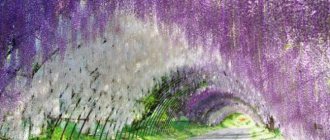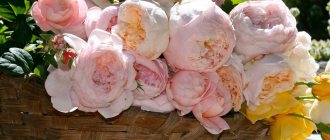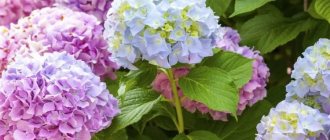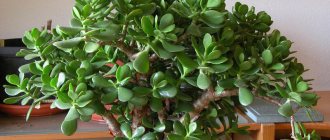Bushes and trees
0
381
Article rating
Kira Stoletova
Cedar elfin pine began to be cultivated in 1817. To date, this is one of the most commonly used plants in landscape design in England.
Cedar dwarf: a woody bush that can decorate any area
Briefly about dwarf cedar
Elfin cedar is a small creeping tree crop from the pine family. The crown is cup-shaped, because it is formed by highly spreading branches. The bark of the plant is dark brown. There are whitish spots and some flaking. The branches have smooth, gray bark. They themselves seem to lie on the ground, but their tops grow upward. The young shoots of this tree are initially green in color and only darken over time. Needles up to eight centimeters in length, structure in the form of three sides, color blue-greenish. They are placed in small bunches, about five needles in each.
It takes a long time for pollinated buds to mature, approximately twelve to fifteen months. They themselves are not huge, up to seven centimeters in length and up to three centimeters in height. This tree also produces small brown nuts in the shape of an oval. The nut will not be more than one centimeter in length and no more than six millimeters in width. However, this crop begins to bear seeds only after twenty to thirty years.
The root system is quite unusual. First, the central root is formed, followed by the lateral ones. But over time, the main root dies off as unnecessary. And the tree itself continues to develop sides, which are located on the top of the soil.
Diseases and pests
Rust is the worst enemy
Rust is considered the main disease. It appears in the form of yellow bubbles on the needles. If left untreated, the plant begins to shed its needles. At the same time, the decorative qualities of dwarf wood are reduced.
To prevent this disease, it is necessary to promptly trim the affected branches, after which they are treated with immunostimulants. The tree is fed with microfertilizers.
Schutte is the second most common illness. The main sign of damage is the yellow-brown needles of the plant in the spring. Upon closer inspection, black growths on the needles become noticeable.
It is difficult to treat, it spreads quickly, especially in ornamental thickets. If a fungal disease is detected, the affected branches are removed and then sprayed with Hom.
Prevention consists of spraying dwarf elfin with 1% Bordeaux every spring and autumn.
Among the pests you should be wary of are the following insects:
- Hermes Siberian. The main symptom is the formation of white plaque and cobwebs on the needles. For treatment, spraying and injections of insecticides are used. To completely cure the tree, the procedure will have to be carried out two or three times.
- Aphid. Prefers young plants with soft needles. To prevent aphids, it is recommended to fight against the ants that cultivate them. Elfin wood is sprayed with solutions of Decis, Fufanon or similar substances.
- Shield. It appears in the form of small brown round bumps. As a result, it leads the plant to the death of the bark and crooked growth of young shoots. To get rid of the parasite, use trapping belts for low levels of infestation and insecticides like Fitoferm for high levels.
Elf cedar population
This representative of woody plants is well adapted to depleted soils and low temperatures. Due to the fact that its roots are located quite close to the top of the ground, it does not mind the cold. And because of its creeping growth, it survives the winter under a good layer of snow.
Its growing areas are quite extensive. It can grow both in the Far East and in Eastern Siberia. And in the north it can grow even beyond the Arctic Circle. In the southern regions it forms dense thickets in the mountains, at an altitude of eight hundred to nine hundred meters above sea level.
Description of the plant
Elf pine, also called dwarf pine (lat. Pinus pumila) and glauca, belongs to the Pine family. This is a tree crop of small size, creeping, in favorable growing conditions with a decorative, lush, widely spread crown, which can have various types:
- Cup-shaped crowns spreading low above the ground.
- Tree-like crowns that form in plants growing in valleys protected from strong winds.
Thanks to this diversity, dwarf dwarf is defined both as a creeping coniferous shrub and as a densely branching tree.
Plants with a tree-like crown grow in the form of trees, reaching an average height of 4-5 m, their maximum height can be 7 m. The diameter of the trunk at the base is about 14-18 cm.
The creeping forms of the dwarf tree are practically pressed to the ground, rising upward only with the tips of the shoots to a height of a maximum of 50 cm. The trunks of adult specimens of plants that are 100 or more years old are 20-25 cm wide and 10-12 m long.
In harsh climates, the creeping form helps dwarf cedar to survive. To achieve this, the plant has developed a special mechanism for pre-winter lodging of trunks, regardless of their thickness. What is unique is that lodging is active, that is, it does not occur under the weight of snow, but with the approach of winter frosts, which are preceded by a steady drop in temperature. In this case, the trunks are anatomically bent to the ground. After the snow falls, they are completely covered with it, and only their outlines can be seen. Moreover, with the arrival of spring, the trunks straighten again and continue to grow as if nothing had happened.
Description of Nordmann fir and planting the plant in the ground
The bark of the plant is gray with spots of brown color located over the entire area of its smooth surface. The wood is incredibly hard. It is so dense that it can be very difficult to break or pierce it.
An interesting fact is that the color of cedar constantly changes throughout its entire life period. At a young age, the branches have a rich green color, and the tops are painted in reddish shades. With age, the plant gradually acquires a light brown color.
The needles of dwarf pine are completely atypical for plants of the Pinaceae family. They are collected in bunches of approximately 6 pieces, colored green with a bluish tint. Each needle has three sides and grows from 5 to 10 cm in length.
The next year after the so-called flowering, which occurs in the first half of summer, purple cones ripen on the branches of the elfin tree. They have an elongated or ovoid shape. Their length ranges from 3 to 6 cm, diameter is about 3 cm.
Pine nuts consist of a kernel and a shell. The nucleolus occupies 43% of the total mass. The remaining 57% of the total mass comes from the shell. The nuts are small in size, approximately 5-8 mm in length and 4-7 mm in diameter. 1 kg can contain about 24 thousand pieces of nuts.
The dwarf pine begins to produce seeds only from 20-30 years of age and this continues throughout life, and the seeds do not ripen annually, but only every 2-4 years.
The root system of this crop first has a traditional pine tap root and lateral shoots. But subsequently the taproot part of the root dies, and the lateral processes located near the surface of the earth develop.
In the places where this plant grows, the moss layer is constantly growing, soil deposits from sand are formed, and the level of permafrost increases. Due to this, the deepened lateral processes of the roots die. Siberian pine has the ability to form new adventitious roots, replacing lost ones.
And also dwarf shoots lying on the surface of the ground can take root. Thanks to such abilities, dwarf dwarf turns out to be an unusually tenacious plant.
Dwarf wood is resinous, hard, heavy and has a specific structure. The growth rings are eccentric, and the curling, expressed in the tortuous arrangement of the fibers, makes it very strong and difficult to split.
Among the impenetrable thickets of elfin wood live many birds and various small animals. The brown bear also finds food there.
These same animals distribute its seeds, which are not equipped with flies. The nuts of the plant are enjoyed by squirrels, sables, chipmunks, mice, as well as some birds - capercaillie, kuksha, and bee-eater. The main distributor of the plant's seeds is the nutcracker , which stores pine nuts in huge quantities for the winter, but does not eat everything. These remaining reserves sprout vigorously in the spring.
The life span of the plant can reach 250 years with gradual, slow growth. It can be seen both in open areas and as undergrowth to various plantings.
When dwarf thickets catch fire, they are completely destroyed by fire. In burnt areas, the resumption of growth of this plant is impossible for several decades, since even the nutcracker leaves these places.
How can you use dwarf cedar
This half-shrub, half-tree also has decorative features. It is successfully used for landscaping purposes: summer cottages, courtyards, parks, alleys, and so on.
You can also get from it:
1) From nuts - high-quality oil;
2) From the cake - delicious halva, cookies, various fillings;
3) Whole nuts - eaten;
4) Crafts are made from wood;
5) Resin and turpentine are obtained from trunks, roots and branches.
This culture is also very useful and is used in medicine, because the turpentine produced from it helps in:
1) Treatment of diseases of the respiratory system;
2) Treatment of diseases of the excretory system;
3) Treatment of skin diseases.
Its young shoots can be used to speed up the healing of wounds and abrasions. And in past centuries it was even used in the treatment of scurvy.
From its needles you can get a natural green dye.
It can also help stabilize slopes and prevent slides. It is also planted along roads.
Landscape designers often use it for landscaping purposes. They decorate alpine slides and hedges.
This plant also has a huge advantage - it produces phytoncides. Phytoncides are elements that fight a variety of pathogens.
Use in landscape design
Landscape designers use creeping cedar for:
- creating undergrowth in front of deciduous and coniferous trees;
- tapeworm planted on dumps;
- soil strengthening, which is often used in nature reserves;
- attic decorations when grown in pots;
- organizing garden compositions on roofs;
- decorate driveways.
Dwarf wood looks advantageous when creating alpine slides; hedges are cultivated from it.
It has a horizontal root system, so it is separated from other plants by at least 2 m for bushes and 4 m for woody forms.
It is not recommended to plant intermediate hosts of rust next to each other: gooseberries, currants and others.
How to grow dwarf cedar from seeds
This plant can be propagated using seeds. They can be purchased at a garden store or assembled yourself.
First you need to prepare the seeds. This is done like this: 1) The nuts should be kept in a room with a temperature of two to five degrees Celsius for about six months; 2) Then they need to be planted in moist soil, maintaining a distance of two centimeters. There is no need to sprinkle soil on top, you just need to throw some damp moss on top. Named moss will maintain the percentage of soil moisture. Since the germination rate of the seeds is not very high, large quantities need to be planted.
Reviews
Gardeners are attracted by the unpretentiousness of the plant, which can grow on completely “junk” soils without any care.
The air, saturated with a fresh resinous aroma and a large amount of phytoncides, is very healthy, improves immunity and performance.
Proponents of a healthy lifestyle are happy to use their own pine nuts and healing pine infusion.
Residents of the southern regions of Russia note the demands of this plant on air humidity and its disease at high temperatures.
Landscape designers consider it exotic, but very promising.
How to prepare a seedling and place for planting
It is very important to choose a suitable location. However, since in nature it grows on any soil, it is not picky about the quality of the soil. If the soil is purely sandy, then you just need to add clay, it should be twenty to thirty percent more than sand. It can grow both in open, illuminated places and in semi-shaded places.
The root system of the bush does not grow deeply, and the branches spread along the ground, so there should be enough space for it.
When choosing a seedling, it is very important to pay attention to its root system. The roots should be in an earthen coma, healthy and undamaged. The branches should be flexible and disease-free. The height of the seedling must be at least fifteen centimeters.
It is important to remember that it is best to choose elevated places for planting, because liquid will accumulate in the lowlands, which will adversely affect the root system of the plant.
Brief information about the variety
- Needle color : green with a bluish tint.
- Tree height : in nature - up to 50-70 cm, in culture - up to 3 m.
- In which regions does it grow : North, Northeast and East of the Russian Federation; cultivated varieties - throughout Russia, except for the far south.
- Planting Features : in an elevated sunny place.
- Immunity : resistance to fungal and viral diseases is observed.
- Life expectancy : 150-200 years.
How to plant correctly
It is best to plant this species in the middle or end of spring. If autumn is dry, then it is possible at the end of summer, beginning of September. Here are a few nuances:
1) It is important to prepare the hole for planting. Its depth should be approximately eighty centimeters. The width needed is two to three times larger than the earthen coma of the plant. At the very bottom of the planting hole, there should be a drainage layer of fine crushed stone, fine gravel, expanded clay. Next, the drainage layer should be covered with a twenty-centimeter layer of sand. And then the hole needs to be filled with an earth mixture of: turf soil, coarse sand and special soil;
2) Even before planting, it is recommended to place the root system in a three percent solution of potassium permanganate for about two hours. This can help prevent possible diseases;
3) When filling the hole with soil mixture, you need to pour out a bucket of water. After planting the plant, you need to pour out two more buckets of water. The root system must not be allowed to dry out;
4) You need to plant elfin wood together with its native lump of earth. This must be done carefully so as not to damage the root system. The neck of the root system should be flush with the ground;
5) If you plant several crops at once, then you need to maintain a distance of three hundred to four hundred centimeters between them;
6) The upper part of the hole must be mulched; the layer should be approximately eight centimeters. As mulch you can use: sawdust, tree bark, sunflower seed husks, and so on.
Landing
The plant takes up quite a large space
It is extremely important to choose the right place to plant the elfin tree, since it takes roots strongly. This plant tolerates transplants very poorly.
Seedling preparation
To prevent the development of diseases, the root part of the seedling is placed in a 3% potassium permanganate solution for 2 hours before planting.
Immediately before planting, the pot with cedar is spilled with water so that the earthen lump sets.
Preparing the site
Elfin cedar tolerates frost well, is wind-resistant and weakly reacts to changes in humidity.
It prefers lighted places, but can grow in slight darkness. In partial shade, the crown loses its splendor.
The tree is undemanding to soil and grows normally even on rocky soil. The only thing the plant cannot tolerate is stagnant water, so gardeners recommend planting this plant at higher elevations.
When preparing a site for planting, certain rules are used.
- The planting hole is dug 2 times the height of the seedling, but not less than 80 cm. The width of the recess should be 2-2.5 times greater than the earthen lump of the dwarf tree.
- The bottom of the pit is covered with a drainage layer 15 cm high. Expanded clay or gravel is used for drainage.
- 15-20 cm of sand is poured onto the drainage, then the planting hole is half filled with soil mixture.
- Afterwards, a full bucket of water is poured into it to avoid drying out the seedling.
- If the soil is too heavy, it is additionally limed with dolomite flour. For 1 sq.m. 500 g is enough.
When planning landscape design, take into account that there is about 4 m between neighboring cedar trees, since dwarf pine trees cannot tolerate replanting. Calculations are made based on the adult state of the plants.
Landing technology
Dwarf dwarf trees are planted from early to mid-April until the end of May. If the weather is warm and dry in the fall, then planting is carried out before the beginning of September.
The earthen root ball is preserved. Plants of different ages have their own rules for deepening the root collar:
- for very small children it is left at ground level;
- in young cedars the neck is 3 cm above the ground;
- for adults - about 10 cm above the soil.
After filling the planting hole with soil, I spill it with 2-3 buckets of water.
How can you propagate dwarf cedar
It is difficult to propagate this species, because it does it very slowly. There are approximately three suitable ways: 1) Purchase grown seedlings;
2) Using purchased or obtained seeds;
3) Using layering from an adult specimen.
It is very good if you have the opportunity to propagate a tree using layering. This is the least labor-intensive method. The branches need to be bent in the ground, sprinkled with a little earth and watered. Roots form at the point of contact with the soil. After rooting, the cuttings can be separated from the parent plant and transplanted to a permanent location.
Features of reproduction
The main methods of propagation of ephedra:
- By layering.
- From seeds.
- Vaccination.
A simple way to grow dwarf cedar is to pin the lower branches to the ground, sprinkle them and water them. This needs to be done in mid-April. Then, during the season, the plant can have time to give roots, after which the cuttings are carefully separated and transferred to a new place. Since dwarf grows slowly, it may take 2 seasons, the main thing is to wait for the roots to appear.
Only an adult plant can be propagated by layering. If there were no dwarf trees on the site previously, conifers are grown by seeds. This is a rather lengthy process, but quite effective. The main requirement is to carry out stratification of dwarf cedar seeds. After this, in the spring they are planted as seedlings and grown under normal indoor conditions.
Decorative dwarf species can be propagated by grafting. Usually this procedure is done in nurseries, where you can purchase ready-made seedlings. As for cuttings, it is practically not used.
Interesting Facts
Yeast masks and lotions are used in cosmetology for acne on the facial skin. They help improve hair growth, nutrition and health, which is why yeast is used for washing and rinsing hair.
The cones of the dwarf cedar are almost 2 times smaller than the cones of the Siberian cedar, but the fruitful years of the cedar are more frequent than those of the cedar. In terms of nutritional value and healing properties, dwarf nuts are not inferior to pine nuts.
The Druids - the priests of the ancient Celts - had deep knowledge about the nature of trees, their connection with man and the cosmos. Among the many healing trees they singled out cedar.
In Christianity, cedar symbolizes greatness, dignity, beauty and Christ the Savior.
According to biblical legend, the Cross of the Lord was made of 3 types of wood - pine, cypress and cedar, fused with roots. On the site where the cedar tree for the Cross grew, the Cross Monastery was built. Of all the plants in the Bible, only cedar is mentioned several times as a healing and cleansing tree.
The chemical composition of dwarf pine nut kernels is close to the chemical composition of Siberian pine seeds. They contain up to 64% fats, approximately 15-20% proteins, as well as carbohydrates in the form of sugars, vitamins, mineral salts, trace elements, tannins and other bioactive substances.
Cedar milk, cream, butter and other highly nutritious products are made from dwarf pine nuts. By whipping cedar cream, you get butter. It is used in pharmaceuticals for the preparation of medicines, in cosmetology - for the preparation of creams and other cosmetics.
Sources: ru.wikipedia.org , udec.ru, pihtahvoya.ru, edgarcaysi.narod.ru
Similar articles:
Crowberry (Shiksha) - distribution, description, composition, use, preparation, in folk medicine, recipes, contraindications
Shiksha (crowberry, crowberry, ariska, scarlet grass, pigeon, husk, capercaillie, bogwort, shiptun-grass), etc. - these are only Russian folk names, but every people familiar with this plant calls it in its own way...
Medicinal plants of Yakutia
In the flora of the Republic, 1850 species of higher plants are known, 575 - bryophytes (444 - phyllophytes, 131 - liver mosses), 550 - lichens, 2678 - algae and 600 fungi.) ...
Drupes - description, varieties, distribution, composition, beneficial properties, recipes, collection and storage
Rúbus saxátilis (lat. Rúbus saxátilis) is a perennial belonging to the genus Rubus (Rose family), the closest relative of cloudberries, raspberries and blackberries. Drupeberry is easily recognized by its bright scarlet fruits, consisting of 4 fused berries with large seeds, and triple leaves….
Evenks. ethnoscience
The harsh climate of Eastern Siberia subjected a person to severe trials: it required him to exert extreme physical and moral strength to survive, while at the same time the harsh nature formed a strong character and a special worldview. In such a climate, people looked for natural ways to protect their bodies from cold and disease, paying special attention to traditional medicine. ...
Rosehip - description, distribution, collection time, in medicine, contraindications, in folk medicine
Needle rose, Yakut rose hip, in Yakut: deluhuen….
Care
Caring for dwarf cedar is almost not required - it is only important to provide enough space for the actively developing horizontal root system. Well, water and feed if you want to get a lush, beautiful plant.
Trimming. In principle, dwarf cedar does not need pruning, except for sanitary pruning: remove diseased and broken branches in a timely manner. If we are talking about design, it is best to trim “extra” branches before the last ten days of April, not forgetting to treat the cut areas with varnish or paint.
Shelter. In the fall, cover the roots of the plant with straw or peat with a layer of up to 8 cm. Elfin cedar is not afraid of harsh winters, but its crown can be destroyed by a large accumulation of snow - build a pyramid or cube from long slats and cover it with lutrasil.
Types of cedar pines: photos and characteristics
All types of cedar pines belong to the Pinaceae family. Three of them grow in Russia: Siberian, Korean and dwarf cedar. Another species, pine, is common in Italy and North America. All these trees are of high value, not only in cooking, but also in other industrial sectors, in particular woodworking and agriculture.
You can find a brief description of these trees on this page.
Siberian cedar pine: photo and brief description
Siberian pine pine is distributed wild in the northeast of European Russia and Siberia, as well as in China, Northern Mongolia, the Carpathians and the Alps.
This is a perennial tree up to 40 m high, with a pyramidal or wide-spreading crown with several peaks. The trunk diameter can reach 2 m.
When describing the Siberian cedar pine, it is especially worth noting its longevity: the lifespan of this tree is up to 800 years.
The bark on young trunks and branches is ash-silver, with brown transverse lenticels; with age it becomes gray-brown, with cracks. The needles are triangular, about 10 cm long, soft, the branching of the needles is whorled.
Male reproductive organs are located in spikelets, female reproductive organs are located in cones.
Mature cones are up to 13 cm long, up to 8 cm wide, contain up to 140 brown seeds covered with a hard woody peel, the seeds are up to 14 mm long and up to 10 mm wide.
Look at the photo, the cones of the Siberian cedar pine are light brown in color:
Siberian pine pine nuts are used as a delicacy and are also used in cooking.
They are added to cakes and pastries, desserts, fillings for pies and rolls, salads and snacks, main courses, sauces, seasonings and drinks. Cedar oil is produced from them. The cake is used to feed livestock.
The wood is used to make pencils, food containers and other items. The resin of this pine tree is also a valuable product.
Korean cedar pine: photos and characteristics
Korean cedar pine is a perennial tree with a cone-shaped crown, dark gray bark, with cracks, bluish-green needles, triangular, soft, up to 20 cm long and up to 2 mm wide, collected in bunches of 5 pieces, changed approximately every 5 years. The cones are up to 15 cm long and up to 10 cm wide, at first green, and when they fall off they turn brown.
As you can see in the photo, the seeds of the Korean cedar pine are larger than those of the Siberian cedar pine:
A tree lives up to 450 years or more.
Korean pine is common in Korea, Eastern China and Japan. In Russia, this pine is found mainly in the Amur region and Primorye. In cooking, the nuts of this pine are used similarly to the nuts of the Siberian pine pine. Korean pine wood is beautiful in color and texture, has excellent characteristics, and is used in the manufacture of furniture, veneer, plywood and other products.
